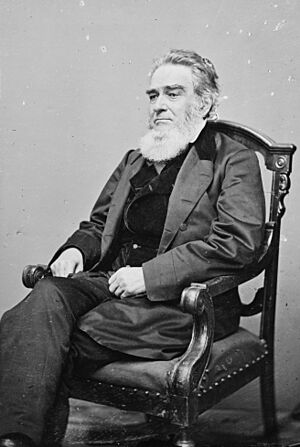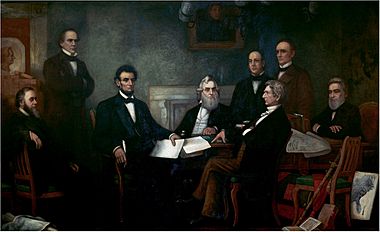Edward Bates facts for kids
Quick facts for kids
Edward Bates
|
|
|---|---|

Portrait by Brady-Handy, c. 1855–1865
|
|
| 26th United States Attorney General | |
| In office March 5, 1861 – November 24, 1864 |
|
| President | Abraham Lincoln |
| Preceded by | Edwin Stanton |
| Succeeded by | James Speed |
| Member of the U.S. House of Representatives from Missouri's at-large district |
|
| In office March 4, 1827 – March 3, 1829 |
|
| Preceded by | John Scott |
| Succeeded by | Spencer Darwin Pettis |
| Attorney General of Missouri | |
| In office September 18, 1820 – November 8, 1821 |
|
| Governor | Alexander McNair |
| Preceded by | Position established |
| Succeeded by | Rufus Easton |
| Personal details | |
| Born | September 4, 1793 Goochland County, Virginia, U.S. |
| Died | March 25, 1869 (aged 75) St. Louis, Missouri, U.S. |
| Resting place | Bellefontaine Cemetery |
| Political party | Democratic-Republican (Before 1825) National Republican (1825–1834) Whig (1834–1854) American (1854–1860) Republican (1860–1869) |
| Relatives | Bates family |
| Signature | |
| Military service | |
| Branch/service | United States Army |
| Rank | Sergeant |
| Unit | United States Volunteers |
| Battles/wars | War of 1812 |
Edward Bates (born September 4, 1793 – died March 25, 1869) was an American lawyer, politician, and judge. He represented his home state of Missouri in the US House of Representatives. He also served as the top lawyer for the U.S. government, called the Attorney General, under President Abraham Lincoln.
Edward Bates was part of the important Bates family. He was the first person from a state west of the Mississippi River to join the President's main team of advisors, known as the US Cabinet.
Born in Goochland County, Virginia, Bates moved to St. Louis in 1814. There, he started his own law office. In 1820, he became the first Attorney General for the new state of Missouri. For the next 30 years, he was elected to Congress for one term. He also served in both the Missouri House of Representatives and the Missouri Senate. He became a well-known member of the Whig Party. He even helped Lucy Delaney win a special court case to gain freedom from slavery.
After the Whig Party ended in the early 1850s, Bates briefly joined the American Party. Then, he became a member of the Republican Party. He was a candidate for president at the 1860 Republican National Convention but Abraham Lincoln won the nomination. Bates was chosen as Attorney General in 1861, at the start of the American Civil War. He helped carry out some of the government's early war plans. However, he didn't fully agree with Lincoln's decision to free enslaved people (the Emancipation Proclamation). He also didn't support full equality for Black people. Bates left the Cabinet in 1864 after he wasn't chosen for a spot on the US Supreme Court. After leaving office, he tried but failed to stop a new state constitution in Missouri.
Contents
Early Life and Education
Edward Bates was born in Goochland County, Virginia. His parents were Thomas Fleming Bates and Caroline Matilda Woodson. His father was born on his family's large farm called Belmont. He also served in the local army during the American Revolutionary War.
Like other children from wealthy families, Bates studied at home when he was young. Later, he went to Charlotte Hall Military Academy in Maryland.
Starting His Career
Edward Bates fought in the War of 1812. After the war, in 1814, he moved to St. Louis, in what was then the Missouri Territory. His older brother James was already there and working as a lawyer. Their oldest brother, Frederick Bates, was also in St. Louis. He had served as Secretary for both the Louisiana Territory and the Missouri Territory.
Edward Bates learned about law from Rufus Easton, a judge. Bates lived with Easton's family while he studied. After he became a lawyer, Bates worked with Easton. In 1817, they helped set up a ferry service called the James Ferry. It traveled from St. Charles, Missouri to Alton, Illinois.
Bates also worked with Joshua Barton, who became the first Secretary of State for Missouri. In 1816, Bates was a second (a helper) for Barton in a duel. A duel was a formal fight with weapons. This duel ended without anyone getting hurt.
Entering Politics
Bates first got involved in politics in 1820. He was elected to be part of the group that wrote Missouri's state constitution. He wrote the introduction to the constitution. He was then chosen to be the new state's Attorney General.
In 1822, Bates was elected to the Missouri House of Representatives. He then served one term in the United States House of Representatives from 1827 to 1829. After that, he was elected to the State Senate from 1831 to 1835. He then returned to the Missouri House in 1835. He also ran for the United States Senate but lost.
Bates became an important member of the Whig Party in the 1840s. His political ideas were very similar to those of Henry Clay. Bates owned enslaved people, but he became interested in the freedom case of Polly Berry. She was an enslaved woman who gained her freedom in 1843. This happened because she had been held illegally in the free state of Illinois years earlier.
After Polly Berry became free, she asked Bates to be her lawyer. She wanted him to help her daughter, Lucy Ann Berry, who was about 14, gain her freedom. The court ruled that Lucy was also legally free. This was because her mother had been proven free at the time Lucy was born. During this time, Orion Clemens, who was Mark Twain's brother, studied law with Bates.
Some experts today say Bates was "generally not supportive of Black freedom." However, he did free all of his own enslaved people. By 1851, he had even paid for his last former enslaved person to travel to Liberia.
In 1850, President Millard Fillmore asked Bates to be the U.S. Secretary of War. But Bates said no. At the Whig National Convention in 1852, Bates was considered for the nomination of vice-president. He even led on the first vote but lost on the second vote.
After the Whig Party broke up in the 1850s, Bates briefly joined the American Party. Then he joined the Republican Party. He was one of the four main candidates for the party's 1860 presidential nomination. Bates first had support from Horace Greeley, but Greeley later supported Abraham Lincoln. The next year, after winning the election, Lincoln chose Bates to be United States Attorney General. Bates held this job from 1861 to 1864. He was the first Cabinet member to be chosen from a state or territory west of the Mississippi River.
As Attorney General
Back then, there was no Justice Department like we have today. Bates had a small office with only six staff members. His main job was to give legal advice to President Lincoln and his Cabinet members. He also handled a few cases in the Supreme Court.
Bates made an important decision about whether Black people could be U.S. citizens. In 1862, a ship was stopped because its captain was African American. Ship captains had to be U.S. citizens. At the time, the Dred Scott decision said that Black Americans were not citizens. In December, Bates said that free African Americans were indeed citizens of the United States. This went against the Dred Scott decision. He later confirmed that citizenship rights were the same for everyone, no matter their race.
Bates's time as Attorney General had mixed results. He was important in carrying out some of Lincoln's early war plans. This included arresting people who supported the South or were causing trouble in the North. However, as Lincoln's plans became more focused on ending slavery, Bates became less involved. Bates disagreed with Lincoln about freeing enslaved people and allowing Black soldiers to join the Union Army. In 1864, Lincoln nominated Salmon P. Chase to be Chief Justice. This was a job Bates had wanted. Bates then resigned and was replaced by James Speed.
Later Years
After leaving the Cabinet, Bates went back to Missouri. He was involved in a debate about new rules for the Missouri constitution in 1865. Bates especially disliked a rule that required people to take a special oath to prove their loyalty. He also didn't like that people who supported the South temporarily lost their right to vote. He wrote seven essays against the constitution, but it was still approved. This new constitution was important because it ended slavery in Missouri. It passed three weeks before the U.S. Congress proposed the Thirteenth Amendment to end slavery in the whole country.
Bates stopped being involved in politics. However, he still shared his thoughts on political events in local newspapers. He died in St. Louis in 1869 and was buried at Bellefontaine Cemetery.
Family Life
Edward Bates married Julia Coalter from South Carolina. They had 17 children together. Julia had come to St. Louis to visit her brother David and her sister Caroline. Her sister Caroline married Hamilton R. Gamble, who was also a lawyer. He later became the chief justice of the Missouri Supreme Court.
Bates was mostly happy with his large family. His four sons had different roles during the Civil War. His oldest son, Barton Bates, served on the Supreme Court of Missouri during the war. His son John C. Bates served in the US Army and later became the Army Chief of Staff. Another son, Fleming Bates, fought with the Confederates. This caused some tension between him and his father. Bates rarely mentioned Fleming in his diary during the war. His youngest son, Charles, was still attending West Point during the war.
See also
- Polly Berry, an enslaved woman who hired Bates to represent her in her daughter's freedom case (1844)
- Lucy Berry, a 14-year-old enslaved girl who gained freedom in a case filed by her mother Polly Berry and argued by Bates
Images for kids


